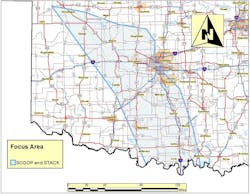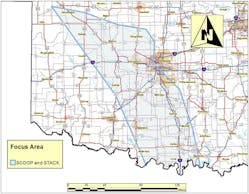The Oklahoma Corporation Commission’s Oil and Gas Conservation Division (OGCD) has developed seismicity guidelines for operators in the South Central Oklahoma Oil Province (SCOOP) and the Sooner Trend Anadarko basin Canadian and Kingfisher counties (STACK).
These areas are expected to account for much of Oklahoma’s future oil and gas activity. SCOOP and STACK producers currently are focusing on crude oil and condensates although there also is associated gas.
OGCD and the Oklahoma Geological Survey (OGS) representatives said they developed seismicity guidelines as a proactive approach.
Numerous earthquakes have been associated with injection wells in the Arbuckle formation. OGCD Director Tim Baker noted the SCOOP and STACK plays are incapable of generating huge amounts of wastewater. In the Arbuckle, produced water is injected into disposal wells.
“Production from the Mississippian limestone and Hunton dewatering play operations within the 15,000-sq-mile earthquake area of interest (AOI) has resulted in an unprecedented amount of salt water which was already in the formation coming up with the oil and natural gas,” Baker said. “By comparison, the SCOOP and STACK plays have very small amounts of produced water.”
OGS Director Jeremy Boak said Oklahoma developed a plan to mitigate earthquake risk in the SCOOP and STACK using both new and old information. The SCOOP and STACK guidelines link possible earthquake activity to hydraulic fracturing.
“Then-state seismologist Austin Holland did some work on small earthquakes some years ago in what is now widely known as the SCOOP and STACK, and showed some of them might have been related to hydraulic fracturing,” Boak said.
Term of the new guidelines are that if an earthquake greater than or equal to 2.5 magnitude occurs within 1.25 miles of fracturing operations, the operator will being internal mitigation but operations will continue.
If there’s a quake greater or equal to 3.0 magnitude, the operator is to halt operations for at least 6 hr and participate in a conference call with the OCC staff. If reduced seismic activity follows, the operator could be allowed to resume operations with revised completion procedure.
Any quake greater than or equal to 3.5 magnitude will result in immediate suspension of fracturing, and OCC staff and the operator will discuss whether continued operations will be allowed.


